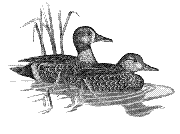US Fish & Wildlife Service
Date of this Version
January 1990
Abstract
Aquatic invertebrates play a critical role in the diet of female ducks during the breeding season. Most waterfowl hens shift from a winter diet of seeds and plant material to a spring diet of mainly invertebrates. The purpose of this chapter is to give managers a quick reference to the important invertebrate groups that prairie-nesting ducks consume.
Waterfowl species depend differentially on the various groups of invertebrates present in prairie wetlands, but a few generalizations are possible. Snails, crustaceans, and insects are important invertebrate groups for reproducing ducks (Table). Most species of laying hens rely on calcium from snail shells for egg production. The northern shoveler and gadwall are dependent on crustaceans that swim in the water and forage on algae and fine organic matter. The northern shoveler has an enlarged bill and finely developed lamellae for sieving crustacea from the water. Early-nesting species such as northern pintails and mallards consume early-emerging midge larvae in addition to earthworms, which are often the most available food in ephemeral wetlands shortly after the snowmelt. The diving ducks consume free swimming amphipods or larger insects such as caddis fly and dragonfly larvae that tend to occur in deeper water.
The community of invertebrates present in a wetland can indicate the history of water changes in that wetland. For example, invertebrates such as leeches, earthworms, zooplankton, amphipods, isopods, and gastropods are dependent on passive dispersal (they can’t leave the wetland under their own power). As a result, they have elaborate mechanisms to deal with drought and freezing. A second group that includes some beetles and most midges can withstand drought and freezing but requires water to lay eggs in spring. A third group that includes dragonflies, mosquitoes, and phantom midges lays eggs in the moist mud of drying wetlands during summer. A fourth group that includes most aquatic bugs and some beetles cannot cope with drying and freezing, so, they leave shallow wetlands to overwinter in larger bodies of water. Managers can use the presence of these invertebrates to determine the effectiveness of water management regimes designed for waterfowl production.
The following descriptions of invertebrate natural history are based on Pennak (1978).



Comments
Published in Diana H. Cross and Paul Vohs (eds.) Waterfowl Management Handbook. Fort Collins, CO: U.S. Fish and Wildlife Service, 1988. Online at http://www.nwrc.usgs.gov/wdb/pub/wmh/contents.html